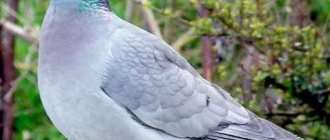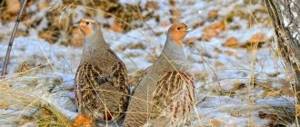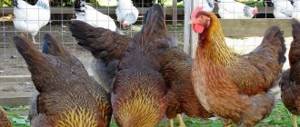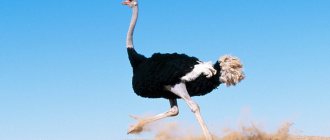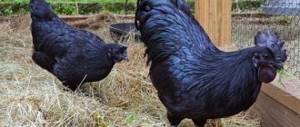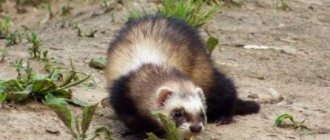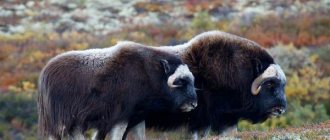They have a small head with a straight beak and large eyes decorated with eyelashes. These are birds, but their wings are poorly developed; they cannot fly. But this is compensated by strong legs. Egg shells were used by ancient Africans to carry water.
People were also partial to their luxurious feathers. They cover almost the entire body of this bird. Males usually have black feathers, with the exception of the wings and tail, which are white. Females are a slightly different shade, gray-brown, their tail and wings are grayish-white.
Once upon a time, fans were made from the feathers of this bird, and ladies' hats were decorated with them. Because of this, 200 years ago ostriches were on the verge of extinction until they began to be kept on farms.
Their eggs, and the eggs of other birds, are eaten, and various products are made from the shells. It is also eaten as meat, it resembles beef, and the fat is added to cosmetics. Down and feathers are still used as decorations.
Fortunately, these friendly exotic birds are not uncommon now; 10 interesting facts about ostriches will help you get to know them better.
Scientific facts about ostriches
- The African ostrich not only holds the record for growth. This breed itself is considered the largest among all. The bird's homeland is the central regions of Africa. Newborn chicks weigh on average 1.5 kg. Due to rapid growth, after 12 weeks the weight of ostrich chicks will be 18-25 kg. Adults can reach a weight of 60-80 kg.
African ostrichAttention! Some African ostriches reached a weight of 136-158 kg. But such indicators are rarely recorded and only in birds kept in unnatural conditions for them.
- The species is one of the few birds that lack a keel in their body structure. Its absence does not allow ostriches of both sexes to fly even short distances. But their wings are well developed and serve as balance while running. If the bird spreads its wing, its span will be 1.8-2 m.
- Ostriches also know how to dance and attract a partner with this behavior. In dance, special importance is attached to the legs and wings. Despite their large growth and bulkiness, the birds move smoothly and with concentration.
Attention! Ostrich wings are an excellent weapon against enemies. They help fight off predators in the struggle for life, as well as from rivals vying for one female.
- The bird's main weapon is its legs.
The lower limbs are distinguished by their power and muscular structure; at the end of the foot there are only two toes. Their distinctive feature is their hoof-like structure. This illusion is created by a huge and sharp claw that grows on the thumb. The hoof serves as additional support during running, and also strengthens the kick several times. A blow from an ostrich's limb is fatal to humans and causes great harm to the animal that attacks the ostrich. - The main diet of the ostrich is plant foods. But the bird is capable of feeding on small reptiles and small animals. The favorite grass of birds is tough; they love young bushes and soft branches. Since ostriches of any kind do not have teeth, they require additional help in grinding food. To do this, the bird swallows small stones. Some individuals can swallow up to 1.5 kg of pebbles.
Features of feeding ostrichesFeed granulator prices
Feed granulator
Attention! The ostrich brain, regardless of the size of the bird itself, is small in size. They rarely exceed 3-4 cm.
- Birds of this species differ from their relatives in the structure of the digestive tract. As soon as food enters the oral cavity, it immediately moves to a section called the proventriculus. There the food is moistened and moved further. In the stomach, food is crushed by stones and dissolved with the help of gastric juice. The main process of digestion of coarse foods occurs in the intestines.
Ostrich eggs are the largest among birdsAttention! Ostriches have the longest intestines of any living bird. The length of the small intestine is 5 m; the length of the large intestine is 8 m.
- Ostriches can reach high speeds thanks to their strong legs and wings. After special studies conducted in Africa, it was possible to prove that in the presence of danger, individuals are capable of reaching speeds of up to 80 km/h. The average speed of a moving herd when danger appears is at least 75 km/h.
- Ostriches are distinguished by their long life; there are cases when ostriches lived for more than 75 years, this is one of the longest indicators in the animal and bird world.
- It is interesting that birds also have organized sleep. They are able to sleep standing or sitting, with their neck always in a vertical position. Birds rarely close their eyes during sleep. Therefore, to determine the condition of the ostrich, you need to listen to its breathing. In sleep, it is calm, uniform, and there are practically no movements of any kind.
- Under no circumstances should you approach the bird during the mating season.
A person is perceived as a threat and a direct rival, so the bird will make every attempt and effort to drive you away from itself. Ostriches can reach speeds of up to 80 km per hour - Ostriches are freedom-loving individuals. If you decide to start breeding them, you should take care of having a large and clean range. At the same time, if possible, it is better to separate the young animals with the female from the main herd in order to avoid accidental trampling of the babies.
- When breeding individuals in farm yards, they should be well fed with vegetables and roughage to ensure a sufficient vitamin and mineral balance for the birds. On natural pastures of the wild environment, the bird replenishes it on its own.
Attention! The bird should not be disturbed during sleep. Ostriches have such perfect hearing that they can hear an approaching object several meters away. If you disturb a sleeping individual, it may attack and the blow will be fatal.
No. 7 Common Rhea
Weight: up to 40 kg
Throughout the entire American continent, this bird is considered the largest. She has strong legs, so she can reach speeds of up to 56 kilometers per hour. The primary habitats of representatives of this species are the territories of Paraguay, Uruguay, Argentina, as well as other countries of South America.
The largest bird in the world
The African ostrich is called the largest bird because... it grows up to 2m 70 cm and weighs 156 kg .
They live in Africa. Once upon a time they could be found in Asia. But, despite such enormous size, this bird has a small head and a tiny brain, no larger in diameter than a walnut. Legs are their main wealth. They are adapted for running because... have powerful muscles, with 2 fingers, one of which resembles a foot. They prefer open areas, avoid thickets, swamps and deserts with quicksand, because... they wouldn't be able to run fast there.
Flying birds names. What types of birds fly the highest - list, characteristics and photos
their forelimbs evolved into wings, allowing them to fly. Some species, such as the black swift, spend ten months of the year in flight. They eat, sleep and even mate in the air. On the other hand, there are migratory and predatory birds that can rise to altitudes from 9,000 to 11,300 m. This article presents the ten highest flying birds in the world, with a brief description and photo.
The ranking below is based on the maximum recorded flight altitudes of various bird species, which are capable of reaching incredible heights as they fly long distances in search of food and to breed.
White stork (4800 m)
The White Stork (Ciconia ciconia) is a species of migratory bird that can fly at an altitude of about 4800 m. These birds have a distinctively long neck, an impressive height of about 100-125 cm, and a wingspan of 155-215 cm. The species lives in the western part Central, but fly to South in the winter months. White storks migrate in flocks. The large wings of storks allow them to soar on warm air currents without exerting significant physical effort.
Godwit (6000 m)
The Godwit (Limosa lapponica) is a migratory bird species that spends the breeding season in Siberia and Alaska. In winter they fly to New Zealand, southern Europe and Asia. These birds feed on worms, aquatic insects, etc. Godwits hold the record for the longest continuous flight - more than 11,000 km.
Mallard (6400 m)
A migratory species of bird from the Anatidae family, which is found in Europe, but migrates to Asian countries such as India in winter. They can reach altitudes of up to 6400 m, although they are usually found at altitudes of 300-1200 m. The mallard (Anas platyrhynchos) has an average lifespan of up to 10 years, but some individuals manage to live up to 20 years.
Andean condor (6500 m)
The Andean condor (Vultur gryphus) is a large bird species, reaching a weight of about 15 kg. Lives in the Andean mountains of the continent. They are scavengers that feed on dead animals. The condor has an impressive wingspan of up to 320 cm, and can rise to a height of about 6500 m. The species is on the verge of extinction due to habitat loss and overhunting. Considered the national bird of many Latin American countries, including Chile, Ecuador and Bolivia.
Bearded Man (7500 m)
The bearded vulture (Gypaetus barbatus) lives in the highlands of southern Europe, Asia and Africa. With a wingspan of up to 280 cm, these birds can fly steadily at altitudes of up to 7500 m. They rise to great heights to drop large bones until they crumble into small fragments. The bearded vulture's digestive system is capable of digesting small bone chips within 24 hours.
Alpine jackdaw (8000 m)
Alpine jackdaws (Pyrrhocorax graculus) are birds that are perfectly adapted to the lack of oxygen at altitude. These are not only high-flying birds, but also the highest nesting birds on the planet. Alpine jackdaws build their nests at altitudes above 6,400 m. They have been recorded soaring near Everest at altitudes of up to 8,000 m.
Whooper swan (8200 m)
The whooper swan ( Cygnus cygnus ) is a migratory bird species that inhabits wetlands in Europe and Asia. Whoopers nest near lakes, ponds and wetlands. The species received this name because of its “screams.” During migration, whooper swans usually fly in "V" formations at altitudes of around 2500 m, although they are capable of reaching altitudes of up to 8200 m.
Top articles : Red flags: Why your cat won't eat or drink for several days
Bar-headed goose (8800 m)
Bar-headed goose (Anser indicus) is a species of migratory bird found in the mountain waters of Central Asia. These birds are able to rise to a height of up to 8800 m and fly over the mountain peaks of the Himalayas in conditions of low atmospheric pressure. During the winter months they fly south. The bar-headed goose can fly up to 1,600 km in just one day during migration.
Common crane (10,000 m)
The common crane (Grus grus) lives in northern Europe and Asia in summer and migrates to North Africa in winter. These birds fly in V-shaped flocks, even over the Himalayas. During the migration period, gray cranes rise to 10,000 m to avoid eagles in mountain passes.
African vulture (11,277 m)
Photo: Lip Kee/Wikimedia Commons The African vulture (Gyps rueppellii) is a species of bird of prey native to central Africa. Their body is adapted to extreme altitudes and low oxygen levels. The blood of the African vulture contains special hemoglobin, which absorbs oxygen much more efficiently. They rise to high altitudes not to fly long distances, but to get a better view of the area. The African vulture has keen eyesight and can detect prey from an altitude of 11,000 m.
African ostrich
It is the African ostrich that is today recognized as the only ostrich on the planet. According to the modern classification, Nandu and Emu do not belong to ostriches, but are the closest relatives of their brother from Africa. And it is the African ostrich that is the largest in the world; its height is comparable to the growth of a good breeding stallion. If you measure the height of a bird from head to toe, you will get no more or less than 2.5-2.7 m. And the weight of a large bird sometimes exceeds 150 kg.
It must be said that the ostrich is distinguished not only by its impressive dimensions, it is one of the most unusual living creatures. Let's start with its name, literally translated from Greek - it is a camel sparrow. Further: although the ostrich is a bird, it lacks the charm of flight. It has no keel and its bones are not as hollow as those of most birds. Nature compensated for the inability to rise into the air with another quality - the giant runs very fast.
Another feature: despite its impressive dimensions, the ostrich has a disproportionately small head. Hence the talk about the meager mental abilities of the bird. The conversations, it must be said, are not without background. The bird's brain is comparable to the size of its eye. At the same time, the ostrich's eyes are one of the largest in the animal world, beautifully fringed with long eyelashes.
Moving on, the ostrich has several more unique features. For example, he has a bladder, but no goiter. And if you look at the feet of the African giant, you will see only two fingers - the only case in the bird world. At the same time, one finger is large, leathery, with a massive claw, reminiscent of a hoof. And the second one is much smaller and weaker.
The ostrich is also a very strong bird, so you shouldn’t get too close to it. The blow of a powerful paw carries a charge of 50 kg, and an adult male can easily carry a person. The ostrich is also a long-liver and can live up to 60-70 years.
The following types of ostriches from Africa are known:
- Malian. Its range is North Africa: Ethiopia, Senegal, Morocco and Mauritania.
- Somali. It can be found in Somalia, Kenya and Ethiopia. Females of the Somali subspecies have more pronounced brown plumage.
- Maasai. Distributed in eastern Africa. It differs from its counterparts in the unusual red color of its legs during the mating season.
Treatment of currant bush with boiling water in the spring in April 2021, protection against pests and diseases: when can you water
Rare animals of the world
15
Tarantula spider (Poecilotheria metallica)
In addition to being incredibly rare, this member of the animal kingdom is also one of the most beautiful tarantulas. This spider lives in the tropical forests of southwestern India, building houses high in the treetops. Younger representatives of this species live at the roots of the tree, where they can dig holes and weave thick webs around them. In case of danger, they hide in their holes.
14
Madagascar beaked turtle (Astrochelys yniphora)
This species of land turtle, also known as the angonoka, is critically endangered. Endemic to Madagascar, the IUCN Rare Species Commission has declared it one of the most “vulnerable” animal species on our planet. Today, Angonoku can be found in a small area in the north-west of the island of Madagascar. The density of these animals in nature does not exceed 5 individuals per square kilometer. In total there are 250-300 individuals per 100 square meters. km. In captivity you can find 50 representatives of this species.
13
Peter's proboscis blenny (Rhynchocyon petersi)
This rare animal species is listed in the International Red Book as “at risk of becoming extinct.” Also known as the red-shouldered blenny, this mammal, a member of the jumping family, lives in Africa. The species received its name in honor of the German zoologist Wilhelm Peters. Peters's proboscis blenny can be found in the forests of southeastern Kenya and northeastern Tanzania.
12
Angelfish (Squatina squatina)
Listed as a Critically Endangered Species on the International Red List, the sea angelfish (also known as the European squatfish) can be found in the seas of the northeast Atlantic, namely in the hot and temperate zones. Representatives of this species of shark from the order Squatinidae are similar to stingrays due to their enlarged pectoral and ventral fins. They are most often found on the ocean floor and feed mainly on flounder fish.
11
Northern long-haired wombat (Lasiorhinus)
Being on the verge of extinction, this wombat is considered one of the rarest animals on our planet. There are fewer of them on Earth than Sumatran tigers. There is only one extremely small population left in the Epping Forest National Park, which is located in the center of Queensland, Australia. Scientists believe that the reason for the decrease in the population of these animals is changes in their habitat. Add to this the fact that wombats are the favorite prey of dingoes. Wombats usually live in eucalyptus forests, meadows with lush grass and loose soil.
10
Hunter's Bubal (Beatragus hunteri)
Also known as hirola, this species of the hirola genus is listed as Critically Endangered in the Red Book. The hirola lives in the northeastern regions of Kenya and the southwestern regions of Somalia. Before this species became rare, its representatives inhabited an area of 17,900 - 20,500 square meters. km. Today, their distribution area is about 8,000 square meters. km.
9
Smalltooth sawfly (Pristis microdon)
Also listed in the Red Book as a “Critically Endangered Species,” the sawnose ray is a fish from the family of sawfish rays. The habitat of these representatives of the animal world is the waters of the Indo-Pacific region. Sometimes these rays can enter rivers.
8
Tonkinese rhinopithecus (Rhinopithecus avunculus)
This species of mammal of the monkey family is also on the verge of extinction. Already at the beginning of the second half of the 20th century, the range was quite limited. Representatives of this species were found only in the forest near the Song Coy River in Vietnam. Tonkin Rhinopithecus was discovered in the provinces of Tien Kwang and Vac Tai. At this time, monkeys can also be found in several other provinces of Vietnam.
Best articles: Organisms living in the soil: fauna, bacteria, fungi and algae
Reasons for breeding ostriches on farms
This bird species is an excellent investment for good returns. Ostriches are used for several purposes, which can be found in the table below.
Table 1. Economic reasons for breeding ostriches.
| Cause | Peculiarity |
| Feathers | — Used to make costumes for carnivals — 1 kg of down is obtained from one bird — One batch of feathers is 0.5-1 tons |
| Meat | — Distinguished by its red color — Healthier than turkey and chicken — Distinguished by a specific smell |
| Eggs | — One ostrich egg replaces 40 chicken eggs — Requires long-term cooking — Characterized by increased protein levels — Shells are sold separately if necessary |
Video - Breeding ostriches
Attention! Despite the good economic opportunities for raising poultry, it is important to first find a good market, since for now traditional varieties of meat and eggs are in first place. You can read more about ostrich breeding in our special article.
Ostriches are a good economic investment
Prices for popular models of grain crushers, feed cutters and grass cutters
Royal albatross
This bird is the largest among sea flying birds. The largest albatross is the royal albatross, which is famous for its wingspan. Its size is just under 4 meters, with a body length of 120 cm and a weight of about 10 kg. The bird's habitat is the southern seas and the coast of Antarctica.
Albatrosses are wanderers and never sit still. Moving from island to island, birds build nests, which are a kind of navigation landmarks. Royal beauties choose only the islands of New Zealand for nesting and raising chicks. Interestingly, in pirate legends and myths, an albatross circling near a ship always predicts a storm.
How high can it reach?
The African ostrich is not only the largest bird in size and weight, but also the tallest in the world. One of its main distinguishing features is its long straight neck. Thanks to her, this resident of Africa can see the enemy at a very great distance. So let's get back to her growth. Today it is known that the height of an ostrich can be on average 2.7 meters. Of course, this figure applies to males; females are slightly smaller in size, their height rarely exceeds 2.5 meters.
If this indicator of a bird is compared with other animals, then it is not inferior even to a large horse. On average, the height of a riding horse at the withers is 1.68-1.70 meters. As you can see, the feathered representative has gone far, which cannot be said about his head. His brain is no bigger than a walnut. But great growth is a merit of long legs and a long neck.
Waxwing
8th place in the ranking of the most beautiful birds on the planet is occupied by the Waxwing, which is the closest relative of the common sparrow. The average weight of birds does not exceed 70 grams. Waxwings are periodically “nomadic” birds that nest in the northern part of Russia, in the tundra and taiga. They are also found in certain areas of North America. In addition to berries, seeds and young sprouts of plants, midges, dragonflies and even butterflies are caught in flight. By winter they appear in the Moscow region and fly to the Caucasus and Crimea. At this time, ornithologists are actively studying them, since waxwings lead a secretive lifestyle in their nesting places. In winter, birds sometimes get drunk because of overripe berries, which they mainly feed on at this time. Because of its beautiful pinkish plumage and large pink crest, as well as its pleasant iridescence, it is sometimes kept in cages.
Best articles: The first Russian circumnavigation - history and main events of the expedition
The name translates as “camel sparrow”
The word “ostrich” came to us from the German language, Strauss came from the Greek “strouthos” or “strufos”. It was translated as “bird” or “sparrow”. The phrase “strufos megas” meant “big bird” and referred to ostriches.
Another Greek name for it is “strufokamelos”, which can be translated as “camel bird” or “camel sparrow”. At first, this Greek word became the Latin “strucio”, then it entered the German language as “strauss”, and later came to us as the familiar “ostrich”.
Territory of residence – Africa
Ostriches have long been domesticated; they are bred on farms, i.e.
These birds can be found all over the world. But wild ostriches live only in Africa. Once upon a time they were found in Central Asia, the Middle East, Iran, India, i.e. occupied larger territories. But due to the fact that they were constantly hunted, they were simply exterminated in other places, even the numerous Middle Eastern species.
Ostriches can be found almost throughout the continent, except for the Sahara Desert and the north of the mainland. They feel especially good in nature reserves where hunting birds is prohibited.
Sigmatura giraffe
The Sigmatura giraffe, which lives in Central Africa, is the tallest in the world. His height is 5.86 m.
Sigmatura giraffe
The animal's natural habitat is the African savannah, which is a network of national parks. People also call such giraffes in Latin “camelopard”, which means “cameloleopard” . This amazing animal, in its characteristics, combines a horse, a leopard, an antelope, a camel and even a donkey. Giraffes appeared on earth 25 million years ago, but despite this, they still feel great in the world around them.
Characteristics of the giraffe
In order for the entire body and head, located at the end of the long neck, to be supplied with blood, nature endowed the animal with a huge heart, which weighs 12 kg. It creates pressure that is 3 times greater than that of a person. The circulatory system is equipped with special valves that regulate blood flow. Without them, the animal would die by simply lowering its head.
The giraffe's stride length can reach 6 m. It runs very fast and can overtake a racehorse, but at a short distance. Even if the giraffe moves slowly, you will still have to run after it. He ambles, first moving his right legs, then his left. Jumping high is easy for a giraffe. He can easily jump over a barrier 2 m high. But he will not be able to walk through a swamp or other body of water due to his large body mass and long thin legs.
In order for the entire body and head, located at the end of the long neck, to be supplied with blood, nature endowed the animal with a huge heart, which weighs 12 kg.
Giraffes are peace-loving animals, but if there is a fight between them, they will fight with their necks. This can mainly happen between males because of a female. They live in herds, each with a leader. He stands out from the rest with his head held high and his neck straight. A female giraffe gives birth while standing. He falls to the ground from a height of almost 2 m.
Particular attention should be paid to the giraffe's tongue. Its length is almost 0.5 m and it consists entirely of muscles. Thanks to its tongue, the giraffe grabs the highest branches and easily breaks them off. But if an animal gets its tongue entangled in tree branches, it may die. Thanks to the length of its tongue, the animal cleans its ears with it. The area around the mouth is covered with a stratum corneum that protects the giraffe from thorns on plants, and thick saliva coats the branches for comfortable swallowing.
In order to drink water, the giraffe spreads its legs wide and bends its front knees slightly. But the animal, like the camel, can go without water for a long time.
We should also note the interesting coloring of the giraffe. In this she is similar to a leopard. If you watch a giraffe eating leaves from trees, you can accurately determine the sex of the animal. Males try to pick off the tops of trees, and females eat leaves at their height.
Record figures
Ostriches have a very long neck. Nature has endowed birds with such a feature that they can see danger from afar. The neck increases the height of the individual. The height of the male is 2.7 m. The females are slightly lower. Their height can be 2.4-2.5 m. In one of the African farms, a group of ostriches was selected to form the parent flock. They were on a special diet. Experts noted the great growth of one of the males. It was 3 m 10 cm.
This is the tallest ostrich, but the record was not recorded and it was not included in the Guinness Book. Despite this, many Africans are proud of the fact that they own the largest ostrich in the world.
Another indicator was recorded in the book of records. Females lay the largest eggs. The dimensions are impressive. The length of the ostrich egg is 22 cm, the width is about 13 cm. The shell is very strong. The empty egg is widely used by artisans who make amazingly beautiful souvenirs from it.
With certain processing, the shell looks like porcelain. The average weight of an egg is 2 kg, but the Guinness Book includes an ostrich egg weighing 2 kg 270 g. It was brought by a female who lived on the farm of one of the Swedish entrepreneurs. The record was recorded in 2008.
The largest ostrich is the African ostrich. Individuals of this subspecies live in Central Africa. They give birth to the largest chicks. Newborn chicks weigh 1.5 kg. After just 3 months, the young animals can have an impressive weight. The body weight of males is 20 kg, females 18 kg. Chickens grow and develop quickly. The weight of an adult individual can reach 130 kg, but this is already a record. On average, males weigh 70 kg, females 60 kg.
Ostriches feed on plant foods. Sometimes they can catch a grasshopper or find some kind of insect in the grass. The source of food for the livestock is hard savannah grass, young shoots of bushes, and small branches. Birds must use small stones to break down coarse fibers. The total weight of stones in an ostrich's stomach can reach 1.5 kg.
The bird has a unique gastrointestinal structure. The ostrich does not have a goiter. From the oral cavity, food immediately enters the proventriculus, where it is partially hydrated. In the stomach, food is crushed by stones and gastric juice. The main breakdown of coarse fibers occurs in the intestines. He has the longest of all land birds. The length of the small intestine is 5 m, the large part of the gastrointestinal tract is 8 m.
Ostriches are the fastest birds that do not have a keel. The record figure was revealed by scientists. They observed wild birds in the African semi-desert. The individuals sensed danger when they heard a car approaching them. They tried to escape from a potential enemy. One of the males reached a high speed of 80 km/h. The main population moved at a speed of 76 km/h.
If birds are stressed and view humans as a dangerous object, then they become very aggressive. You should not approach ostriches at this time. They can attack.
Igor Nikolaev
auto RU
You should not interfere with males during the courtship dance, during the period of courtship with the female. Individuals may perceive a person as a rival. They will definitely try to drive him away.
The life expectancy of an ostrich is quite long. Individuals can live 75 years. They are considered long-lived. Birds sleep sitting or standing. They hold their neck vertically. Eyes may be open. You can determine that an individual is sleeping by the bird’s calm behavior, uniform breathing, and lack of movement. You should not approach an ostrich when it is sleeping. Birds have good hearing. They will definitely hear steps, get scared, and may attack.
How to win a Gemini man and win his heart forever?
Australian pelican
Pelicans are one of the largest flying birds in the world, the Australian one has the longest body length - up to 190 cm, and a curly wingspan - 3.5 meters. The largest representatives weigh up to 14 kilograms.
In addition, the Australian pelican has the largest beak in the animal world, its length reaches 50 cm, and its flight speed is quite high, up to 50 km/h.
Nandu
Nandu is, one might say, the younger brother of the African giant. Junior because it is smaller in size. It is the third largest bird after the African and Emu. Nandu's homeland is South America. If the African ostrich lives in the savannas of Africa, then its American relative lives in the savannas, prairies and llanos of America, on the mountain plateaus in the Andes.
Rhea is often called the American ostrich. Although it is incorrect to classify it as an ostrich species, this bird belongs to another order and family, namely the rheas. Although in appearance the Nandu and the African ostrich are very similar. Both do not fly, both have a massive body with long legs, a small head and a long neck. But there are a number of significant differences.
For example, Nandu has 3 toes on his feet instead of two. Because of this, he runs somewhat slower, although he is also quite fast. In addition, Nandu is the only ratite bird that does not have a gall bladder. The Nandu's neck is covered with feathers, while the African's is completely devoid of vegetation. And, despite the fact that Nandu is also a flightless ratite bird, he uses his wings.
When he accelerates, he raises one of his wings, perhaps this way he controls the air flow and can run faster.
In general, the existence on different continents of such similar-looking birds as the African ostrich, Rhea and Emu is explained by the term convergent evolution. This is a process when living beings that are not closely related acquire similar external characteristics not because of belonging to the same species, but because of evolutionary formation in similar conditions. Therefore, perhaps all the ostrich breeds announced today are not related by blood.
There are two types of American Nandus:
And then a video for all those who are interested in unusual birds from South America. Video from the VideoEffect channel.
Swan
This representative of waterfowl is the most beautiful and noble creature on the planet. Nowadays, there are 7 subspecies of swan. The largest is considered to be the mute swan, the male of which weighs about 13-15 kg (and even more), has dimensions of one and a half meters and a wingspan of just under 2.5 meters. Thanks to the highly developed muscles of the wing, the bird makes flights over thousands of kilometers.
The amazingly arched, long neck helps the bird in underwater hunting for small fish and insects. Swans are monogamous and choose a mate for life. The male and female together incubate the eggs and care for the chicks. If one dies, the other swan commits suicide. This is probably why the bird has been sung since ancient times as a symbol of purity and fidelity.
The benefits of ostrich meat
Externally, ostrich meat resembles beef. It is just as red, the fatty inclusions are barely noticeable, and the meat is a lean variety. 100 g of carcass contains 98 kcal, which makes the product dietary, while there is a lot of protein, iron, and zinc inside. Ostrich meat contains a large amount of vitamins B, PP. Among the minerals, potassium, magnesium, iron, phosphorus, and selenium are distinguished. Poultry carcass rarely causes allergic reactions and is well digestible. Among the benefits of meat identified by doctors are:
Ostrich meat is soft and juicy. Tastes like veal with a slight aftertaste
According to world sanitary and culinary standards, ostrich meat is classified as second grade. It is processed into minced cutlets, sausages and sausages. When preparing meat, preference is given to the loin of the bird's thigh.
Emu
Emu is an “ostrich” from the Australian continent, which is home to the most outlandish and unusual creatures of this world. The emu is another large bird and is the second largest after the African ostrich. The emu is also not an ostrich, although it is often called that. It belongs to the order Cassowariformes. There were times when the Emu was called a beast, but now there is no doubt that it is a bird.
The emu is quite similar in appearance to the Nandu and the African Guest, but it is a completely peculiar and unique bird. His height is less than that of an African, about 2 meters, and his weight does not exceed 60 kg. In addition, the Emu has three toes; in our world, only the African ostrich has two toes. The plumage of the Emu is also unique. It looks more like wool, the feathers are not interlocked and stick out scatteredly to the sides. Another rare Australian bird, the Kiwi, distant relatives of the Emu, has this type of fur or feathers.
Like all ostrich-like ratites, Emus are excellent runners, but besides this, they also love to swim. A common sight in the Australian expanses is Emu splashing in shallow water bodies. The Australian Emu is famous for its easy-going nature and peaceful nature. They get along well with people and are ubiquitous on ostrich farms around the world, where they are raised for their valuable meat, skin, feathers and eggs. Which, by the way, have an unusual blue-green color.
It must be said that only recently has Emu been “left alone.” Due to the fact that Australian birds damaged farmland, they were mercilessly exterminated. Hunting dog breeds were even specially bred for these purposes.
In addition to the Emu, the Australian continent and the tropics of New Guinea boast another unusual bird - the cassowary. Translated from the indigenous language, “cassowary” means “horned head.” The Cassowary, like its close relative the Emu, boasts a respectable size. With a height of 1.5-1.8 m, it weighs approximately 60 kg. The cassowary differs from the emu in having a horny process on its head, which many call a “helmet.” The cassowary is in turn divided into the helmeted cassowary, the muruca and the orange-necked cassowary.
In addition to the “helmet” on its head, the cassowary has a brightly colored neck and elegant earrings. Two earrings will indicate a helmeted cassowary, one - an orange-necked one, and their absence - a muruc. The cassowary is a dangerous and aggressive bird. The claw on its three-toed paw is very sharp and long, and the Cassowary often uses it, especially when scared or cornered.
In 2004, the cassowary was included in the Guinness Book of Records as the most dangerous bird in the world; meeting one on one often promises death.
No. 3 Helmet-bearing Cassowary
Weight: up to 83 kg
This bird is widespread in Indonesia, most often it is found in the tropics - in wooded areas. It will not be difficult to meet her in New Guinea, Australia (in the North-East of the country). The altitudes in which this representative of birds lives are small, mainly up to 1100 meters, and in some countries - even up to 500 m. As for the size of the bird's body in height, it is up to 170 centimeters, and the mass, in turn, is equal to up to 50 kilograms, if we talk about males, and up to 68 kilograms, if we talk about females. The maximum growth rate that was recorded in the cassowary is 190 centimeters. The helmeted cassowary is the largest breed of bird in Asia and Australia. At least since the disappearance of the Arabian ostrich. Today it is the world's largest surviving representative of birds, although the "growth" of the emu in some cases can be much higher.
They don't bury their heads in the sand
The thinker Pliny the Elder was sure that when they see a predator, ostriches hide their heads in the sand.
He believed that then these birds seem to be completely hidden. But that's not true. Ostriches bow their heads to the ground when they swallow sand or gravel; sometimes they select these hard pebbles from the ground, which they need for digestion .
A bird that has been chased for a long time may lay its head on the sand, because... she doesn't have the strength to lift it. When a female ostrich sits on a nest to wait out danger, she may spread herself flat, bowing her neck and head to make herself invisible. If a predator approaches her, she will jump up and run away.
Raising chicks
Dimensions
Newborn ostrich chicks are about 20 cm in height. They grow at a rate of about 1 cm per day to a value of 150 cm.
Feeding
For the first three days, it is recommended not to feed or drink babies so that their gall sac resolves. The ambient temperature is maintained at 32-33°C. On the fourth day, the ostrich chicks are given a mixture of crushed clover or alfalfa leaves with mixed feed (as for broiler chickens) and water. At the same time, they begin to give cottage cheese and boiled eggs. At the 5th week of life and up to 3 months, the chicks are fed with compound feed, as for broiler chickens. Be sure to place separate feeders with gravel or small stones. Young ostrich chicks switch to grass food in the summer, eat root vegetables (potatoes, carrots, beets) in the fall, and eat silage in the winter.
Bustard and African Great Bustard
Bustard
African Great Bustard
- Weight: up to 18 kg.
The bustard (Otis tarda) and the African great bustard are probably the heaviest flying birds alive. The bustard can be seen in central, southern Europe and Asia. However, 60% of the population is currently found in Portugal and Spain. Male bustards typically reach 90–105 cm in height, about 115 cm in length and have a wingspan of 2.1–2.7 m. The weight of an adult male can range from 5.8 to 18 kg. Females are much smaller. They weigh from 3.1 to 8 kg.
The African Great Bustard (Ardeotis kori) is native to Africa. The length of a male African bustard is 120-150 cm, height - 71-120 cm, and the wingspan can reach about 230-275 cm. Males usually weigh from 7 to 18 kg. Females weigh on average from 3 to 7 kg.
Have no close relatives among other creatures
The order of ratites are the ostriches. It includes only one representative - the African ostrich. We can say that ostriches have no close relatives .
Ratite birds also include cassowary-like birds, for example, emus, kiwi-like birds - kiwi, rhea-like birds - rhea, tinamous-like birds - tinamu, and several extinct orders. We can say that these birds are distant relatives of ostriches.


